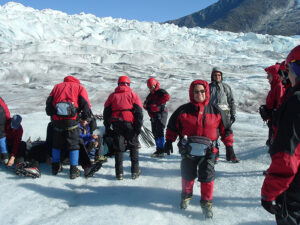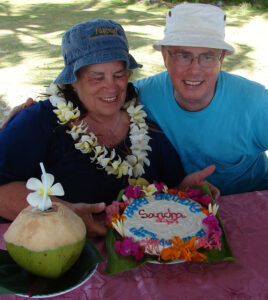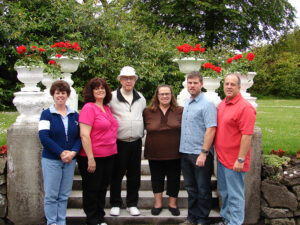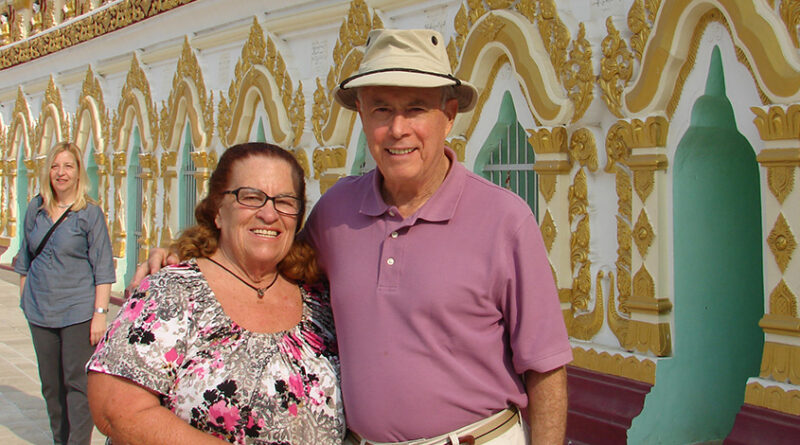Where in the world is sandra scott?
By Steve Yablonski
Well, she is in Oswego now — after more than four decades traveling the world. In total she visited more than 70 countries writing about many of them for a variety of publications and companies, including 55 PLUS
Sandra Scott started traveling the world in 1986. And, she’s still on the go.
“It’s sort of an interesting story. I always wanted to travel. But Mexico is a great place to bring up kids,” the octogenarian said of The Mother of Towns in Oswego County.
She’d gotten to the point where she realized that she probably wasn’t going to be able to travel, she said.
“I had three kids in college and I had an 8-year-old at home. So I thought, ‘well, it isn’t going to happen.’ I made sure all four kids did a foreign experience. I didn’t want them to think that Mexico was the center of the universe,” she explained.
OPPORTUNITY CALLS

Then, the phone rang. It was her father.
He had been cleaning out the safe and found canceled checks from before World War II. They used to send money to her grandmother in eastern Czechoslovakia, she said.
There was an address; so they wrote to it. The person they wrote to had died — but it was a small town so everybody in town knew who they were.
They got three letters back inviting them to come. It was behind the Iron Curtain.
“My father said, ‘your mom wants to go and your aunt wants to go.’ He said if I plan everything, he’d pay my way. So I was on that!” she said. “I started thinking — I’m not sure I want to leave an 8-year-old home with three college kids. So I said I’m going to take him with me.
“And then, my husband decided he didn’t want to stay home with three college kids, either. So, all six of us went.”
It was an eye-opening experience.
The next year, they decided to go to the Soviet Union.
“And then we just never stopped [traveling], she said.
After she retired, they ventured into Asia and started spending four months there in the winters.
“We have done a lot of South America, too. We actually traveled around Europe and then we went to South America,” she said.
When her youngest son got to college, he had a foreign semester in Singapore. They went to visit him for his 21st birthday.
“Asia was easier than Latin America,” she said. “They are much better organized and things are relatively inexpensive. They have budget airlines; where you can fly from one country to another for like $100.”
In the process, she started writing for a lot of people. At one point, she wrote for all the in-flight magazines for the Latin American airlines.
“And I wrote for Copley News Service. I don’t think anybody knows who they were. They were a syndicate and so actually some of my articles appeared in the Syracuse newspaper; that’s how the Syracuse people knew about me,” she said. “One day I came home from [teaching] school and found that they asked me to write a travel column. So I did that for 10 years, while I was still teaching (seventh grade social studies at Mexico Middle School)—it was like doing mini term papers every week.”
Every time they went to Asia they had to plan their visit according to the visas, most are good for 28 days.

“We’d bounce around; went to almost every place in Asia except Yutan (a sub-district in Ningxiang City, Hunan Province, China). It’s just too expensive to go to,” she explained. “We’d always spend four weeks in Thailand. One of the things we learned is that if you go to the popular places, that Americans go, then the prices are high. So what you want to do is you want to go to the places where the Europeans are going; they go and stay all winter. It’s kind of like us going to the Caribbean or something.”
One of her favorite places is in Myanmar.
“I think we’ve been there eight times. When we first went there it was pretty closed off. But it changed rapidly. That’s why they’ve run into problems — I think they just changed too fast,” she said. “They have a lovely beach there [Ngapali Beach] on the Bay of Bengal. It was like two miles long. There was nobody on it. And of course they are Buddhist; so they’re all easy to live with and kind and caring.”
TRY IT, YOU’LL LIKE IT
“I really like Vietnamese food. Actually, most of the food in foreign countries isn’t very exotic,” she said. “We did go to a place — didn’t eat there, but we did go years ago in Vietnam — where you could pick out your wild animal. You could get food with snakes in it and stuff like that. My husband was good at trying just about anything. Those things are usually expensive, anyhow.
“I like Thai food, too. It’s a bit hotter. Vietnamese food generally isn’t too hot. If you go from Thailand and then go to Cambodia and so on, the food gets milder. Unless you go to Chongqing — that’s very hot. The spicy hot food [hot pot] in China is found In Chongqing and other places which is part of the Sichuan cuisine. Definitely Asian food is the best, I think. It’s more diverse and a lot of vegetables. Japanese food is not my favorite.
“We found it interesting that Chongqing had a museum dedicated to an American World War II general — General Joe Stilwell — and across the street is one to the Flying Tigers,” she added. “We were told that Chinese students learn that Claire Lee Chennaut was the leader of the Flying Tigers. So much to know, so little time.”
Actually, the world is very safe, she noted. There have been some trouble spots from time to time.
“We were supposed to go to Kiev or Kyiv as it is today, and that was when Chernobyl happened. So we had to go north to Warsaw and then we took the train from Warsaw over to Moscow,” she said.
“Actually, we never had any real problems. Because we traveled for such a long period of time, we ended up being on the way to places when things happened; a tsunami in Thailand for example,” she said. “Before everything was deregulated, there used to be a travel company in California; they had wonderful things — they had ‘round the world tickets for $900, they had circle the Pacific, they had circle Southeast Asia. We were already on our way. So, when we got to Thailand we hadn’t planned to go down to where the tsunami happened, but they were offering buy one airplane ticket, get the second one free. So, we went down and stayed there, then continued on.”
“When we were in Saipan, it was when the Japanese tsunami hit and so we had to go to our room, which was on the seventh floor. The tsunami wasn’t really great in our area; just about three feet or so,” she added. “We went to Japan a couple weeks later. It actually worked in our favor because it was cherry blossom time. We were like the only people there. In fact, the hotel we stayed at had closed off all the top floors. There were like no tourists there, it was beautiful.”
When traveling, she speaks English.
“I used to know some Russian and I try to stammer through Spanish,” she said. “English is the first most common second language. If you go to Asian countries, they want their kids to learn English because it helps get them a better job. I learned to say hello and thank you in a bunch of different languages. If you’re traveling, more people speak English than you might imagine.”
In China, she had a free guide; they’re usually college kids who are learning English, she explained.
“They take you places where a regular tour guide wouldn’t. You’re not supposed to tip them or feed them,” she said with a sly smile that hinted she didn’t adhere to the policy.
She loves to go to natural heritage sites.
“The Great Wall, the pyramids — it’s amazing the things mankind has built over the centuries,” she said. “I’ve been to Easter Island, and the Inca walls; we have no idea how they moved those stones. They shaped those stones so you can’t get a piece of paper in between them.
“That’s one of the things about travel — it opens your eyes all these possibilities. Also one of the things I learned is that the world is much safer than it looks like. And number two, people are nice almost everywhere. We just have to learn to get along.”
She recalled her first time in Red Square.
“It was the Soviet Union then — and the little girls from school, they were all so cute. They had braids and these big puff white ribbons in their hair. I said to myself, ‘I don’t know whose enemy they are, but they’re not mine,’” she said.
Does she ever wonder how many miles she’s logged over the years?
“No. But my husband loved to fly. He actually had a pilot’s log and he kept track of every flight he ever took from the time he was 12 years old and went to Ireland,” she said. “He went through three books.”
STAYING IN TOUCH
There are a couple people they’ve been in touch with.

“During the Communist days, we had to pay for everything up front, including our food. When we were leaving what was then Czechoslovakia, we had a stack of food coupons and we were getting ready to go to Germany,” she recalled. “We saw this man and woman walk out of a restaurant. I said, ‘could you use these?’ They said, ‘yes.’ We exchanged addresses; we went back and met with them later.”
“I said to one guy in Saipan, or maybe it was Guam, if you are ever in the States let me know. So, wouldn’t ya know, six months later he was in Toronto and I said if you get to Kingston, we’ll come and pick you up. And that’s what we did. It was Fourth of July weekend and trying to cross the border then wasn’t a pretty story. But we made it,” she said.
“The U.S. was very, very slow in getting hepatitis shots; so we’d go to a clinic in Syracuse and get the vaccination that would raise our immune system for several weeks,” she said. “When we went to Guatemala, we had to get polio vaccine again. It was quite a few years ago, but they had had an outbreak there. I was glad that we got them because when we went down into the Amazon, if you couldn’t show that you’d had the vaccination, they gave it to you in the airport.”
“I used to say to my son, when he was young and traveling with us, ‘where would you like to go this summer?’ and that’s what we’d do. He finally got to the point where he said, ‘I’d like to go somewhere where I don’t have to get shots!’” she laughed.
She currently has several mementos of her journeys scattered around her apartment in downtown Oswego. Among them are Shillelaghs and other Irish walking sticks, vases from Nicaragua, a scenic picture from Budapest, a couple pictures that a painter from Prague gifted her with, and a large wooden box that was hand-carved in Honduras.
“When I moved [from Mexico, New York[, I really downsized,” she explained.
She’s planned and coordinated travel to more than 70 counties plus many United States locations.
“When I wasn’t traveling, I was volunteering. I am one of the founders of the Mexico Historical Society and Mexico Point Park. I am a trustee for both organizations,” she said. “I co-authored two of the local historical books.”
“When winter comes, I’m going to Panama for the third or fourth time and just stay at a hotel — I have a lot of hotel credit,” she added. “And then, we’ll all go to Jamaica in January, the family; we rented a house. When we get done with Jamaica, I’ll come home for a couple days and then I’ll go to Cancun for three or four weeks.”

